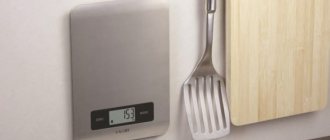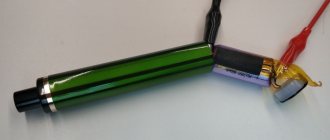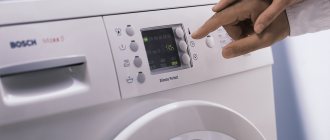Unit design
Structurally, the scales consist of several components:
- Frame. In most cases, it is made of glass, metal or durable plastic. Each of the materials is characterized by a number of advantages. If deformed, the body of the scale cannot be repaired.
- Load cells. The components are located on the rear wall of the unit and are plates made of metal.
- Display. Serves to display the necessary information. In most cases, devices are black and white.
- Printed circuit board with microcircuits. The mechanism is located inside the weighing device and has a reliable protective housing. Four sensors are connected to it. With its help, data is read and displayed on the display. The board of the scale determines its functionality.
Features of electronic scales
Electronic scales are a much more complex device, in contrast to a similar mechanical device. The readings in the electronic device are displayed, and the operating principle is based on the functioning of the voltage sensor. The device is turned on automatically (when a person stands on it) or using a special button.
Important! The weighing error ranges from 100 to 1000 g, and the maximum load from 100 to 220 kg, depending on the model. manufacturer and cost.
Electronic floor scales consist of the following elements:
- Display.
- Load cells.
- Electronic printed circuit board.
- Buttons.
Major breakdowns
The most common malfunctions of weighing equipment are:
- calibration complications;
- cable damage;
- breaking contacts;
- reducing the area of the contact ends;
- failure of the electronic board.
Do not forget that the reason for stopping the operation of the scale may be a dead battery. In this case, you just need to replace the battery in the device.
To combat equipment malfunctions, first of all, it is necessary to diagnose it. To do this, it is important to examine each spare part of electronic scales and the integrity of the wires.
The use of floor-mounted electric units requires a constant load on their surface. All this load is equally distributed to the strain gauge sensors, which over time can malfunction. Failure of one of the system sensors leads to incorrect operation of the device as a whole. As a result, the weight on the device display is incorrect.
Repairing electronic scales on your own is a rather complicated process. Equipment repair requires the use of special tools, skills and knowledge.
Device of electronic floor scales
The product consists of several elements. As a rule, experts distinguish the following parts of it:
- display;
- frame;
- printed circuit board with various microcircuits;
- strain gauges.
Classic floor scales with a glass body. Features a display, circuit and 4 sensors
The body of the product can be made of plastic, glass or metal. Each option has its own advantages. If the case is deformed, it is almost impossible to repair the scales.
The most important part of the scales are the load cells. They are metal plates that are located on the back of the product.
Open load cell plate. The sensor converts the force of deformation into kilograms
Inside the product there is a board that reads the data and displays it on the display. The functionality of the scale depends on the electronic board. 4 sensors are connected to the board. The entire structure is reliably protected by the housing. The display in most devices is black and white. It displays all the necessary information well.
- What is verification and calibration of scales?
The device is powered by a battery. Uses a miniature battery (button battery)
How to find the cause of malfunctions?
It is very difficult to diagnose equipment on your own. To do this, you will need to perform the following algorithm of actions:
- Inspect the device in detail for deformations.
- Unscrew the protective feet from the load cells and inspect them.
- Disassemble the case and check all components inside the system.
When carrying out repair work, you cannot do without a special tool (screwdriver, soldering iron (in case of a wire break), spare sensors).
Loop repair
This failure occurs when digital values are not fully displayed on the display. The scale cable is a system of wires connecting the electrical board and the display. To carry out the repair you need:
- Disassemble the body and check the integrity of the part.
- The cable comes off if the digital data is not displayed in full.
- It is necessary to properly solder components that come off or use conductive special glue.
All work is carried out with caution, as there is a possibility of damage to the electrical board.
Repair of electronic scales
Electronics require a precise approach. The repair process must take place in strict accordance with the rules, one at a time.
The operating principle of electronic scales is based on the functioning of voltage sensors, thanks to which the device’s readings are displayed on a liquid crystal display. Depending on the model, the device can be turned on automatically when exposed to a load or by pressing a button.
Note! Electronic scales may have a weighing error of 100–500 grams. It is also important to take into account the maximum load of the device, which ranges from 100 to 220 kg for different scale models.
Elements that make up electronic floor scales:
- display;
- strain gauges;
- electronic printed circuit board;
- buttons.
Preparatory work
First of all, you need to determine what the problem is. Defect identification includes:
- checking batteries;
- inspection of appearance;
- checking all electrical contacts;
- checking the condition of scale parts.
Let's take a closer look at them.
Checking the batteries
The scale may not display numbers clearly or may not turn on at all. This is a reason to check the state of the power supply. The process is quite simple: take out the battery and check it with a tester. If this device is not available, you can do it even simpler: place the battery in any other device with the same type of power. If it does not turn on, then the problem may be in the battery, and most likely it will be enough to replace it. Otherwise, you need to look for other reasons.
When conducting such a check, consider two important factors. Just because a battery works in another device does not always mean that it will give the same result in a scale. The battery’s contacts could also have oxidized. The reason for this could be a violation of storage rules, for example, at high humidity. Try wiping the battery contacts with a flannel cloth, it is quite possible that it will work again. But still, the most reliable way would be to check with a tester.
Inspection of appearance
Carefully inspect the scale from all sides for any changes that have occurred in it compared to its normal state. This could be deformation of a part, a crack, melting or charring. Each such defect indicates where the fault is located.
Checking all electrical contacts
Perhaps this check will help you repair the device right away. If you find a torn or detached wire, just solder it in place. The same must be done if the track on the board is damaged.
This is done as follows. Take fine sandpaper and clean the damaged area with it, then degrease it, wipe it with white spirit or another solvent and sand it. Create a jumper over the defect or solder a large layer of tin. When the solder has cooled, coat it with varnish. You can use regular nail polish.
Checking parts and their condition
If the previous manipulations did not reveal the problem, you need to check the condition of the scale parts. Approach this with extreme care. You will need precision tools: an angle, a caliper and a level. Look carefully to see if the internal frame is deformed and what condition each part is in. This way you can detect hidden defects.
Repair work
Having determined the type of malfunction, prepare the tools that will be needed for repair:
- pliers;
- screwdrivers;
- soldering iron;
- tester.
You will also need a clean rag to wipe away dust and dirt. If it is necessary to restore the tracks on the board, you may need a solvent, varnish and sandpaper.
Elimination of mechanical defects
Device malfunction can be caused by exposure to a mass exceeding the maximum permissible. The load cells are located at the corners of the inner frame, which bends under too much weight.
You can determine the presence of such deformation using a level or measure it with a caliper. Fixing the problem is not difficult: just straighten the frame at the bend. This can be done by gently tapping the deformed areas of the frame with a hammer, constantly measuring the result with a level. Thus, the functional balance of the sensors will return to normal, and the functionality of the device will return.
Note! It is recommended to remove the frame from the scale before alignment.
Loop repair
Electronic scales may stop displaying numbers if the contact of the cable with other parts weakens. Disassemble the scales, carefully inspect the cable - a set of wires collected in a ribbon connecting the display and the printed circuit board to each other. If the cable contacts are loosened, the display does not receive power, which is why the characters on it are not visible. You need to ensure a tighter connection of the contacts in the cable to the board. Lift it slightly and press it against the display with a suitable size block, ensuring permanent fixation. Such a block can be cut from a piece of wood or take a regular office eraser. The block will tightly fix the board, restoring contact, and the device will function again.
If a damaged wire is found in the cable, solder it at the break site.
Display damage can also be detected by other symptoms. Are there any visible stains, smudges, or air bubbles on it? This is a clear sign that the problem is not with the wires, contacts or cable. When my scales had this problem, I had to take them to the workshop. The display was replaced: the failure was in its matrix, the ink simply spread over the internal surfaces. This problem cannot be fixed at home with your own hands.
Video: soldering a cable in an electric scale
Problems with strain gauges
Another necessary part of electronic scales is strain gauges. They are responsible for converting the load level into a signal, which becomes the image of numbers on the display after processing by the electronic board.
The scales contain 4 such sensors: they are built into each leg at the corners of the scales. Mechanical impact does not destroy them, but the wiring coming out of the sensor may break. They need to be soldered, but this can be difficult to do. The problem is that the sensor is very small and housed in a rugged housing.
The performance of strain gauges can be determined using a tester. To do this, unsolder all sensors from the board and measure their resistance. Without load on the scale, the resistance of all load cells will be approximately the same. A larger deviation in resistance values will indicate a malfunction of any of the sensors.
The sensor itself may fail, but this happens very rarely. This malfunction can be determined by ringing the part with a tester. If the result is negative, then the sensor is replaced with a new, serviceable one. This task can be difficult, since the part is filled with a compound - a special glue. If you manage to find strain gauges in an electrical store, take 4 of them at once and install them in place of the old ones. You can also replace the damaged sensor with a part with similar resistance values from an identical scale model.
If you are unable to find a new sensor, try carefully picking out the compound. Inside you will see a copper plate with three soldered wires. If one of them is broken, just solder it back in place. Usually this is enough to restore the scales to functionality.
Calibration of electronic scales
The accuracy of their readings directly depends on how well the scales are calibrated. Violation of calibration does not affect the performance of the device, but the scales will not be able to display the measured mass correctly.
Restoring calibration is carried out as follows.
- Place a certain weight on the scale platform - any thing whose weight you know down to the gram. This is necessary in order to determine whether the device is actually showing incorrect information about the weight acting on it.
- Press the power key and do not release it. After a few seconds, the letters CAL will appear on the display.
- After some time, the device will display the word PASS. Then the inscription will be deleted. After this, you need to turn off the device. This way the data is reloaded, and after turning on the scales will show the correct information.
This was the only method that helped me calibrate electronic scales myself. If it turns out to be ineffective, take the scales to a service workshop: only there there are special instruments for carrying out accurate calibration, which, most likely, has gone completely wrong at the hardware level.
Note! The load you will use must weigh no more than the weighing limit of the device.
Video: what calibration of scales means and how to do it
Cleaning electronic scales
Another reason for the device to not work can be dust and dirt getting inside. Disassemble and carefully clean the internal surfaces of the device. To do this, use a clean rag, and at the places where the board parts are fastened, use a soft small brush. Do not use detergents or cleaners as they may be harmful to electronics. Cleaning of any electronic devices should be done “dry” and in a switched off state. Carry out the work carefully and carefully: the parts are fragile and can easily be damaged.
Electronic scale errors
Usually we expect numbers from scales to indicate body weight, but sometimes letters or other symbols appear on the display. Let's figure out what they mean.
- If the letters LO appear on the display, this is a signal about the low battery level. This is a system message, short for "low battery". To correct the situation, it is enough to replace the battery, which has exhausted its resource, with a new one. After this, the functionality of the scale will be restored.
- The ERR does not indicate that the scale is faulty. Any electronic device can reboot on its own, after which the system requires an update. If you see this error, step off the scale and wait until the display returns to “0.00.” Now you can repeat the weighing.
- After the batteries have been replaced, the display may show 8888. This is normal: changing the batteries causes a reboot, after which the scale is in the initialization process for some time. This usually lasts 5–30 seconds. Just wait until the value 8888 disappears from the monitor.
- The “—–” indicator indicates that the weight sensors are not functioning properly. In this case, it is enough to restart the scales or change the battery.
- Some (professional) types of electronic scales have additional functions, such as determining your body fat percentage. The message Err-h on the display of such scales indicates that this indicator is above the limits of the upper range of the scales, Err-L - that it does not reach the limits of the lower limit.
Different weights on the same scales: what to do?
Owners of bathroom scales sometimes encounter the fact that the device produces different body weight readings. There are several reasons why this happens.
- The scales are standing on an uneven surface. This makes the device unstable and tilts when you step on the platform. The same happens if the device is placed on something soft, such as a carpet. Place the scale on a flat, hard surface and then weigh yourself to get an accurate result.
- The correct position of the body on the platform is also important, especially the placement of the legs: try to place your feet strictly parallel to each other.
- When weighing, stand straight so that your body is perpendicular to the scale platform. Any movement may cause the reading to change. For example, if you try to put your weight on your toes, you may become “heavier,” but if you try to put your weight on your heels, you may become “lighter.”
- The room in which the scales are constantly located should not be subject to sudden and frequent temperature changes. Electronics are highly sensitive; they often fail when moisture enters or elements overheat, which damage the contacts and even break the wires.
- Do not keep the scales close to heating devices, stoves, or fireplaces. Electronic devices may give incorrect results due to intense heat due to damaged contacts.
- Improper maintenance also causes errors in the operation of the device. When cleaning the scale, do not use any chemicals. Most often, it will be enough to wipe them regularly with a dry cloth.
Repairing sensors
If the scale breaks down due to sensor failure, you need to determine the type of problem (separation of wires, bending or complete breakdown). If the mechanism is bent, it will need to be straightened. In most cases, only one load cell of the device is damaged and you will need to carry out the following work:
- Press down on each sensor with your hands. In this case, the weighing equipment should turn on.
- Disassemble the device and examine the wiring.
- If there is a break, you need to get rid of it using a soldering iron.
If the sensor cannot be repaired, it must be replaced. You can buy spare parts for scales in the Kitchen Service online store. It is important to choose a part that is fully compatible with your device model.
Calibration problems
Calibration is necessary for the appliance to work correctly. After all, there are no two absolutely identical sensors in the world, even if they are manufactured on the same machine with a minimum period of time.
If one strain gauge fails, it can be completely turned off (designated as “zero”), and its functions can be transferred to the remaining functional ones. This method is suitable as a temporary repair of floor scales, but this approach has a right to life when it is not possible to buy a new part quickly, but you need to work now.
Technically, to carry out the calibration procedure, you just need to press one button specified by the manufacturer of the electrical appliance. And this process usually takes no more than one minute, accompanied by corresponding inscriptions on the screen.
Calibration
This breakdown is sometimes associated with incorrect adjustment of strain gauges, which is the basis for distortions in weight readings. All modern devices must be calibrated every time they are placed in a new location.
Calibration can be done manually. To do this, the following algorithm of actions is performed:
- Press and hold the power button until CAL appears on the display.
- Next, place a weight (the mass of which is precisely known) on the surface of the scale.
- Perform calibration.
- The success of the procedure is confirmed by the appearance of the inscription PASS.
Cleaning Components
There are times when scales malfunction due to accumulated dirt and dust, so they need to be cleaned periodically. Cleaning simultaneously acts as an additional preventative measure for the equipment. The procedure involves completely disassembling the unit and removing accumulated dirt using a brush. The work must be carried out very carefully so as not to damage the cable or wire.
Dust deposited near the strain gauges can greatly distort weight information. Using a rag when cleaning the unit will ensure complete safety for the board and other equipment elements.
Main advantages and disadvantages
Several main advantages of mechanical floor scales make these devices very convenient to use:
- absolute autonomy of work;
- the design of mechanical scales is quite simple, which makes them repairable;
- durability;
- the ability to measure fairly large weights;
- ease of setup;
- low cost.
The main disadvantages include:
- error in indicators;
- lack of additional functions;
- ease of damage. Due to the leaky housing, small objects and dust can penetrate inside. They are common causes of failure of mechanical floor scales.
Many people mistakenly believe that floor mechanical scales are intended only for weighing a person. This is not an entirely correct judgment, since such a device can weigh any objects whose weight does not exceed 160 kilograms. However, this feature must be mentioned in the operating instructions.
Unlike mechanical scales, electronic scales are capable of determining not only weight, but also other indicators, for example, the ratio of fat mass, the level of water in the body. However, additional functionality is not always justified. In addition, the cost of such devices differs significantly from mechanical analogues; it is also unlikely to be possible to disassemble and repair electronic scales with your own hands.











